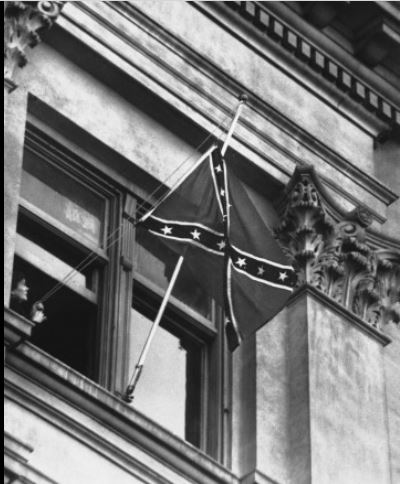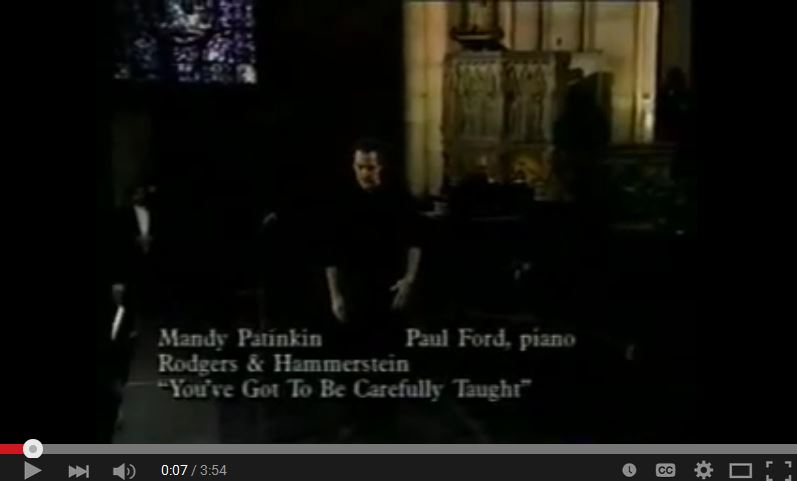Why do People Believe Myths About the Confederacy? Because Our Textbooks and Monuments are Wrong
- Why do People Believe Myths About the Confederacy? Because Our Textbooks and Monuments are Wrong - James W. Loewen (Washington Post)
- "Youve Got To Be Carefully Taught" - by Richard Rodgers and Oscar Hammerstein
Why do People Believe Myths About the Confederacy? Because Our Textbooks and Monuments are Wrong
By James W. Loewen
July 1, 2015
Washington Post
History is the polemics of the victor, William F. Buckley once said. Not so in the United States, at least not regarding the Civil War. As soon as the Confederates laid down their arms, some picked up their pens and began to distort what they had done and why. The resulting mythology took hold of the nation a generation later and persists - which is why a presidential candidate can suggest, as Michele Bachmann did in 2011, that slavery was somehow pro-family and why the public, per the Pew Research Center, believes that the war was fought mainly over states' rights.
The Confederates won with the pen (and the noose) what they could not win on the battlefield: the cause of white supremacy and the dominant understanding of what the war was all about. We are still digging ourselves out from under the misinformation they spread, which has manifested in our public monuments and our history books.
Take Kentucky, where the legislature voted not to secede. Early in the war, Confederate Gen. Albert Sidney Johnston ventured through the western part of the state and found "no enthusiasm, as we imagined and hoped, but hostility." Eventually, 90,000 Kentuckians would fight for the United States, while 35,000 fought for the Confederate States. Nevertheless, according to historian Thomas Clark, the state now has 72 Confederate monuments and only two Union ones.
Neo-Confederates also won parts of Maryland. In 1913, the United Daughters of the Confederacy (UDC) put a soldier on a pedestal at the Rockville courthouse. Maryland, which did not secede, sent 24,000 men to the Confederate armed forces, but it also sent 63,000 to the U.S. Army and Navy. Still, the UDC's monument tells visitors to take the other side: "To our heroes of Montgomery Co. Maryland: That we through life may not forget to love the thin gray line."
In fact, the thin gray line came through Montgomery and adjoining Frederick counties at least three times, en route to Antietam, Gettysburg and Washington. Robert E. Lee's army expected to find recruits and help with food, clothing and information. It didn't. Instead, Maryland residents greeted Union soldiers as liberators when they came through on the way to Antietam. Recognizing the residents of Frederick as hostile, Confederate cavalry leader Jubal Early ransomed $200,000 from them lest he burn their town, a sum equal to about $3 million today. But Frederick now boasts a Confederate memorial, and the manager of the town's cemetery - filled with Union and Confederate dead - told me, Very little is done on the Union side" around Memorial Day. "It's mostly Confederate."
Neo-Confederates didn't just win the battle of public monuments. They managed to rename the war, calling it the War Between the States, a locution born after the conflict that was among the primary ways to refer to the war in the middle of the 20th century, after which it began to fade. Even "Jeopardy!" has used this language.
Perhaps most perniciously, neo-Confederates now claim that the South seceded over states' rights. Yet when each state left the Union, its leaders made clear that they were seceding because they were for slavery and against states' rights. In its "Declaration of the Causes Which Impel the State of Texas to Secede From the Federal Union," for example, the secession convention of Texas listed the states that had offended the delegates: "Maine, Vermont, New Hampshire, Connecticut, Rhode Island, Massachusetts, New York, Pennsylvania, Ohio, Wisconsin, Michigan and Iowa." Governments there had exercised states' rights by passing laws that interfered with the federal government's attempts to enforce the Fugitive Slave Act. Some no longer let slave owners "transit" across their territory with slaves. "States' rights" were what Texas was seceding against. Texas also made clear what it was seceding for - white supremacy:
We hold as undeniable truths that the governments of the various States, and of the confederacy itself, were established exclusively by the white race, for themselves and their posterity; that the African race had no agency in their establishment; that they were rightfully held and regarded as an inferior and dependent race, and in that condition only could their existence in this country be rendered beneficial or tolerable.
Despite such statements, neo-Confederates erected monuments that flatly lied about the Confederate cause. For example, South Carolina's monument at Gettysburg, dedicated in 1963, claims to explain why the state seceded: "Abiding faith in the sacredness of states rights provided their creed here." This tells us nothing about 1863, when abiding opposition to states' rights provided the Palmetto State's creed. In 1963, however, its leaders did support states' rights; politicians tried desperately that decade to keep the federal government from enforcing school desegregation and civil rights.
So thoroughly did this mythology take hold that our textbooks still stand history on its head and say secession was for, rather than against, states' rights. Publishers mystify secession because they don't want to offend Southern school districts and thereby lose sales. Consider this passage from "The American Journey," probably the largest textbook ever foisted on middle school students and perhaps the best-selling U.S. history textbook:
The South Secedes
Lincoln and the Republicans had promised not to disturb slavery where it already existed. Nevertheless, many people in the South mistrusted the party, fearing that the Republican government would not protect Southern rights and liberties. On December 20, 1860, the South's long-standing threat to leave the Union became a reality when South Carolina held a special convention and voted to secede.
The section reads as if slavery was not the reason for secession. Instead, the rationale is completely vague: White Southerners feared for their "rights and liberties." On the next page, the authors are more precise: White Southerners claimed that since "the national government" had been derelict " - by refusing to enforce the Fugitive Slave Act and by denying the Southern states equal rights in the territories - the states were justified in leaving the Union."
"Journey" offers no evidence to support this claim. It cannot. No Southern state made any such charge against the federal government in any secession document I have ever seen. Abraham Lincoln's predecessors, James Buchanan and Franklin Pierce, were part of the pro-Southern wing of the Democratic Party. For 10 years, the federal government had vigorously enforced the Fugitive Slave Act. Buchanan supported pro-slavery forces in Kansas even after his own minion, territorial governor and former Mississippi slave owner Robert Walker, ruled that they had won an election only by fraud. The seven states that seceded before Lincoln took office had no quarrel with "the national government."
Feb. 10, 1938 The Confederate flag flies from the state capitol in Atlanta for the first time since the Civil War.
Credit: Associated Press (AP) // Washington Post
Teaching or implying that the Confederate states seceded for states' rights is not accurate history. It is white, Confederate-apologist history. "Journey," like other U.S. textbooks, needs to be de-Confederatized. So does the history test we give to immigrants who want to become U.S. citizens. Item No. 74 asks them to "name one problem that led to the Civil War." It then gives three acceptable answers: slavery, economic reasons and states' rights. (No other question on this 100-item test has more than one right answer.) If by "economic reasons" it means issues with tariffs and taxes, which most people infer, then two of its three "correct answers" are wrong.
The legacy of this thinking pervades Washington, too. The dean of the Washington National Cathedral has noted that some of its stained-glass windows memorialize Stonewall Jackson and Robert E. Lee. There's a statue of Albert Pike, Confederate general and reputed leader of the Arkansas Ku Klux Klan, in Judiciary Square.
The Army runs Fort A.P. Hill, named for a Confederate general whose men killed African American soldiers after they surrendered; Fort Bragg, named for a general who was not only Confederate but also incompetent; and Fort Benning, named for a general who, after he helped get his home state of Georgia to secede, made the following argument to the Virginia legislature:
What was the reason that induced Georgia to take the step of secession? This reason may be summed up in one single proposition. It was a conviction .?.?. that a separation from the North was the only thing that could prevent the abolition of her slavery. .?.?. If things are allowed to go on as they are, it is certain that slavery is to be abolished. .?.?. By the time the North shall have attained the power, the black race will be in a large majority, and then we will have black governors, black legislatures, black juries, black everything. .?.?. The consequence will be that our men will be all exterminated or expelled to wander as vagabonds over a hostile Earth, and as for our women, their fate will be too horrible to contemplate even in fancy.
With our monuments lying about secession, our textbooks obfuscating what the Confederacy was about and our Army honoring Southern generals, no wonder so many Americans supported the Confederacy until recently. We can see the impact of Confederate symbols and thinking on Dylann Roof, accused of killing nine in a Charleston, S.C., church, but other examples abound. In his mugshot, Timothy McVeigh, who bombed the Alfred P. Murrah Federal Building in Oklahoma City in 1995, wore a neo-Confederate T-shirt showing Abraham Lincoln and the words "Sic semper tyrannis." When white students in Appleton, Wis. - a recovering "sundown town" that for decades had been all white on purpose - had issues with Mexican American students in 1999, they responded by wearing and waving Confederate flags, which they already had at home, at the ready.
Across the country, removing slavery from its central role in prompting the Civil War marginalizes African Americans and makes us all stupid. De-Confederatizing the United States won't end white supremacy, but it will be a momentous step in that direction.
[James W. Loewen, Emeritus Professor of Sociology at the University of Vermont, is the author of Lies My Teacher Told Me and The Confederate and Neo-Confederate Reader.]
"Youve Got To Be Carefully Taught"
written by Richard Rodgers and Oscar Hammerstein
(from the musical South Pacific, which opened on Broadway in 1949, years later, it became a hit movie.)
You've got to be taught
To hate and fear,
You've got to be taught
From year to year,
It's got to be drummed
In your dear little ear
You've got to be carefully taught.
You've got to be taught to be afraid
Of people whose eyes are oddly made,
And people whose skin is a diff'rent shade,
You've got to be carefully taught.
You've got to be taught before it's too late,
Before you are six or seven or eight,
To hate all the people your relatives hate,
You've got to be carefully taught!
Mandy Patinkin singing the song Carefully Taught from South Pacific and Children Will Listen
September 11th Concert Selection Riverside Church NYC




Spread the word